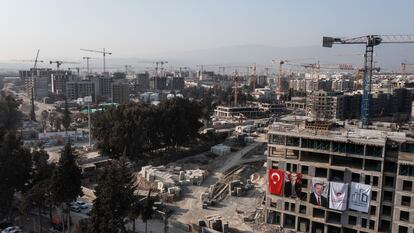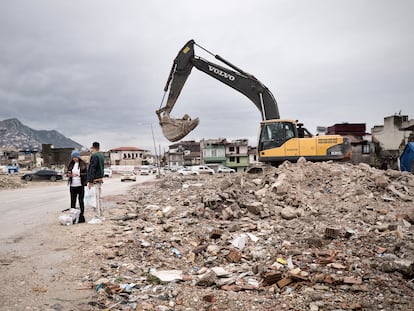The lingering scars of Turkey’s devastating earthquake, two years on
Less than a third of the destroyed homes have been rebuilt, half a million people still live in container settlements, and a large portion of the population continues to suffer from psychological issues related to the disaster


Every day, Mr. Sabahattin opens his barbershop as if nothing has changed. Its location was once ideal — just steps from the main street of the historic center of Antioch, near the market, hotels, and shops, directly across from the Protestant church, and close to the Orthodox temple of Saints Peter and Paul. But now, none of those buildings remain. Only his shop and a nearby hotel stand, surrounded by wastelands and rubble.
“At most, three or four customers come in a day. It’s hard to survive like this — to pay the fees, the electricity, the water for the business,” he laments.
In reality, Sabahattin continues working not for the customers, but because he cannot bear the alternative — the container he has lived in for the past two years since the devastating earthquakes of February 6, 2023, which struck southeastern Turkey and northern Syria. The 7.5 and 7.8 magnitude quakes flattened tens of thousands of buildings, claiming more than 60,000 lives across a region larger than Portugal, and home to over 15 million people.
Like Sabahattin, around 500,000 people in Turkey still live in temporary shelters, prefabricated steel houses, or even tents.
“We had grown used to a 150-square-meter apartment, and now we live in just 21 square meters. It feels like we’re imprisoned — it’s not a place for a family of five,” he says. Gesturing toward the empty lots and ruins, he adds: “We thought that after two years the situation would have improved, but it hasn’t. We are surrounded by destruction, and that’s how we feel too — destroyed inside. We needed care, but the authorities don’t care about the people.”
To some extent, progress has been made. Compared to a year ago, most damaged buildings have been demolished and much of the debris has been cleared. Yet Antioch remains blanketed in dust, the air at times unbreathable. Cranes and excavators are preparing the ground for reconstruction, and new buildings are beginning to rise — but at a much slower pace than promised.
In the weeks following the earthquake, Turkish President Recep Tayyip Erdogan, an Islamist, promised that 319,000 new homes would be delivered by the end of 2023. Two years later, only 201,580 have been completed — not even a third of the homes lost in the disaster. In Antakya, for instance, just over 46,000 new homes have been built, compared to the 300,000 destroyed or severely damaged — half of the city’s pre-earthquake housing stock.
“The promises made after the earthquake have not been kept, and due to the lack of housing, we are forced to live in subhuman conditions,” states a report by the Association of Earthquake Victims of Hatay Province, where Antakya is located.
Life remains difficult in the 400 “container cities” established across the 11 affected provinces. Families are crammed into rows of makeshift shelters that flood when it rains and frequently suffer power outages.
“A lot has been done, but there is still much more to do. The problem was the unrealistic expectations created by the authorities immediately after the earthquake,” explains a source from an international organization involved in the reconstruction.
Not only have entire villages, neighborhoods, and streets been wiped out, so too have the communities that once thrived there. Hundreds of thousands have emigrated, many losing not just their homes, but also their livelihoods. This, in turn, has contributed to a “sharp rise” in the number of children who have to work to support their families, according to a Red Crescent representative in Kirikhan, another town in Hatay.
“A growing concern is the number of school-age children who do not go to school. Depending on the area, in the earthquake-affected region, absenteeism rates are higher than we would like,” says Filippo Mazzarelli, head of operations for UNICEF in Gaziantep province, during a visit organized by ECHO, the EU’s humanitarian aid agency.
Reliving the trauma
“It is very difficult to adapt to this new life in a metal container, where hygiene and proper care cannot be maintained. And this affects self-confidence,” says Rabia, a young psychologist from the town of Kilis.
Living in the prefabricated steel homes or half-destroyed cities prevents victims from returning to normality and causes them to relive the experience of the earthquake. Buildings collapsing, fleeing in the middle of the night, waiting in snow-covered streets while the cries of those trapped under the rubble were muffled as they waited for help that took too long to arrive.
Many compare that experience to an “apocalypse,” writes sociology professor Vehbi Bayhan in the digital magazine Fikir Turu. These stressful situations force victims to relive that trauma, which becomes harder to cope with as support networks — friends, neighbors, and family — have been broken by death and displacement, creating “a feeling of insecurity in the face of everything and everyone.”
In 2024, UNICEF and the Association for Trauma and Mental Health Studies in Disasters conducted a study among families in the earthquake zone. “We found great vulnerability. Forty-three percent of the individuals interviewed exhibited moderate to severe symptoms of post-traumatic stress, 65% suffered from anxiety, and 68% from moderate or severe depression,” explains Mazzarelli. “This indicates that a lot of work still needs to be done.”
Sign up for our weekly newsletter to get more English-language news coverage from EL PAÍS USA Edition
Tu suscripción se está usando en otro dispositivo
¿Quieres añadir otro usuario a tu suscripción?
Si continúas leyendo en este dispositivo, no se podrá leer en el otro.
FlechaTu suscripción se está usando en otro dispositivo y solo puedes acceder a EL PAÍS desde un dispositivo a la vez.
Si quieres compartir tu cuenta, cambia tu suscripción a la modalidad Premium, así podrás añadir otro usuario. Cada uno accederá con su propia cuenta de email, lo que os permitirá personalizar vuestra experiencia en EL PAÍS.
¿Tienes una suscripción de empresa? Accede aquí para contratar más cuentas.
En el caso de no saber quién está usando tu cuenta, te recomendamos cambiar tu contraseña aquí.
Si decides continuar compartiendo tu cuenta, este mensaje se mostrará en tu dispositivo y en el de la otra persona que está usando tu cuenta de forma indefinida, afectando a tu experiencia de lectura. Puedes consultar aquí los términos y condiciones de la suscripción digital.
More information
Archived In
Últimas noticias
The late consecration of women artists in their 90s
The Florida Keys tourist paradise is besieged by immigration agents: ‘We’ve never seen anything like this’
The latest scam on WhatsApp behind the legal dream: using immigration status as bait
Oil, gold and rare earth elements: the backdrop to US political tension with Venezuela
Most viewed
- Families demand repatriation of bodies of Colombians who died in Ukraine: ‘This war is a slaughterhouse for foreigners’
- The low-cost creative revolution: How technology is making art accessible to everyone
- Liset Menéndez de la Prida, neuroscientist: ‘It’s not normal to constantly seek pleasure; it’s important to be bored, to be calm’
- Christian Louboutin: ‘Young people don’t want to be like their parents. And if their parents wear sneakers, they’re going to look for something else’
- ‘El Limones’ and the growing union disguise of Mexican organized crime










































